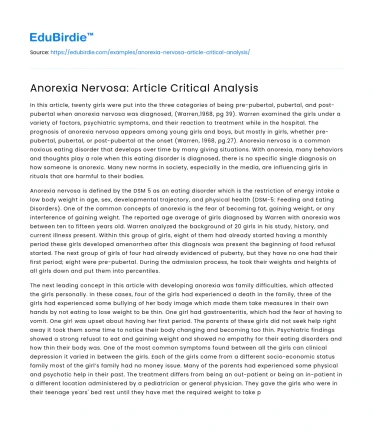In this article, twenty girls were put into the three categories of being pre-pubertal, pubertal, and post-pubertal when anorexia nervosa was diagnosed, (Warren,1968, pg 39). Warren examined the girls under a variety of factors, psychiatric symptoms, and their reaction to treatment while in the hospital. The prognosis of anorexia nervosa appears among young girls and boys, but mostly in girls, whether pre-pubertal, pubertal, or post-pubertal at the onset (Warren, 1968, pg.27). Anorexia nervosa is a common noxious eating disorder that develops over time by many giving situations. With anorexia, many behaviors and thoughts play a role when this eating disorder is diagnosed, there is no specific single diagnosis on how someone is anorexic. Many new norms in society, especially in the media, are influencing girls in rituals that are harmful to their bodies.
Anorexia nervosa is defined by the DSM 5 as an eating disorder which is the restriction of energy intake a low body weight in age, sex, developmental trajectory, and physical health (DSM-5: Feeding and Eating Disorders). One of the common concepts of anorexia is the fear of becoming fat, gaining weight, or any interference of gaining weight. The reported age average of girls diagnosed by Warren with anorexia was between ten to fifteen years old. Warren analyzed the background of 20 girls in his study, history, and current illness present. Within this group of girls, eight of them had already started having a monthly period these girls developed amenorrhea after this diagnosis was present the beginning of food refusal started. The next group of girls of four had already evidenced of puberty, but they have no one had their first period; eight were pre-pubertal. During the admission process, he took their weights and heights of all girls down and put them into percentiles.
Save your time!
We can take care of your essay
- Proper editing and formatting
- Free revision, title page, and bibliography
- Flexible prices and money-back guarantee
The next leading concept in this article with developing anorexia was family difficulties, which affected the girls personally. In these cases, four of the girls had experienced a death in the family, three of the girls had experienced some bullying of her body image which made them take measures in their own hands by not eating to lose weight to be thin. One girl had gastroenteritis, which had the fear of having to vomit. One girl was upset about having her first period. The parents of these girls did not seek help right away it took them some time to notice their body changing and becoming too thin. Psychiatric findings showed a strong refusal to eat and gaining weight and showed no empathy for their eating disorders and how thin their body was. One of the most common symptoms found between all the girls can clinical depression it varied in between the girls. Each of the girls came from a different socio-economic status family most of the girl’s family had no money issue. Many of the parents had experienced some physical and psychotic help in their past. The treatment differs from being an out-patient or being an in-patient in a different location administered by a pediatrician or general physician. They gave the girls who were in their teenage years' bed rest until they have met the required weight to take part in other activities. With mealtime, their eating was closely supervised once they meet the required adequate state of nutrition he would discharge them. Two of the girls from the group had later died, sixteen of them continue the treatment and ten of them had relapsed back into being anorexic.
In conclusion, the article did not go into the specific detail of the treatment given to each group of girls and did not mention more details on how the two girls died and from what? One weakness Warren did not mention what kind of therapy and medication was giving whether it was psychotherapy which is individual counseling that focuses on changing the thinking and the behavior of a person with an eating disorder. In this therapy, it teaches new skills to help build new healthy behavior about food and proper weight gain (Anorexia Nervosa: Management and Treatment). Even after rehabilitation of anorexia, some girls from Warren study relapse and others suffer from different psychiatric problems.






 Stuck on your essay?
Stuck on your essay?

